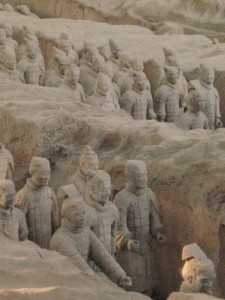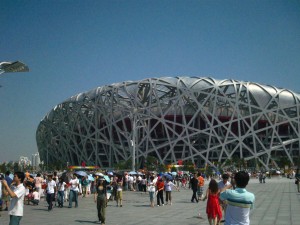China Sector Watch: Tourism
 This series will take an in-depth look at the industries that are shaping the Chinese economy today.
This series will take an in-depth look at the industries that are shaping the Chinese economy today.
By Joyce Roque
Apr. 29 – The tourism industry in China in many ways is still at its early stages. Compared to the other industries that opened up after the reforms made Deng Xiaoping thirty years ago, the industry has developed slowly because of restrictions placed on travel done by Chinese citizens. It was only in 1984 and 1985 that those living in the mainland were allowed to visit relatives and friends in Hong Kong and Macau until finally in 1997, the government allowed citizens to travel abroad for personal leisure. Economic reforms improved income and quality of life that also led to middle-income families being able to afford travel.
It was during this time that Beijing implemented holiday regulations that allowed employees to take a week to 15 days off annually. Beijing has changed holiday dates for the year to lessen overcrowding during the Golden Weeks. Moreover, the working week was standardized to just five days of the week giving employees more time for leisurely activities and rest.
Chinese citizens are allowed to travel both domestically and internationally albeit still monitored and controlled. In the same vein, before reforms happened, only selected foreigners could go enter the country as well. The decision to open the country to the outside world in the late ‘70s brought a trickling of international visitors fascinated to see the China that lay shuttered all these years.
By 2001, as part of its commitment to the WTO, China opened up segments of its travel industry like airlines and travel agencies, to foreign companies. When the global financial crisis hit, China acted quickly implementing new regulations for refunds and cuts to help businesses. For the tourism industry it allowed local and foreign-owned travel agencies to run inbound and domestic tours with a lower registered capital requirement of RMB300,000 from the previous RMB4 million and RMB1.5 million for Chinese tour companies.
Foreign-owned travel companies are also now allowed to expand to more branches nationwide although they are still not allowed to arrange outbound business in the country excluding Hong Kong and Macau and other firms approved by the government. Currently, there are 19,800 registered agencies in China with 18,000 of that number only dealing with managing for domestic tours.
Some cities like Shanghai and Hangzhou have gone so far as to issue discount coupons to spur domestic tourism. In Shanghai, vouchers worth RMB900 million were distributed to residents of the city, Zhejiang province and Jiangsu province for discounts in scenic spots, restaurants, hotels and travel agencies.
Outbound travel
Beijing still tightly controls travels made by its citizens to prevent  illegal immigration usually by requiring large sums of money to be deposited in bank accounts before travel. Only countries given the Approved Destination Status (ADS) are open for Chinese travel. The ADS is a bilateral tourism arrangement between the Chinese government and a foreign country that gives it permission to welcome Chinese tourists for group travel.
illegal immigration usually by requiring large sums of money to be deposited in bank accounts before travel. Only countries given the Approved Destination Status (ADS) are open for Chinese travel. The ADS is a bilateral tourism arrangement between the Chinese government and a foreign country that gives it permission to welcome Chinese tourists for group travel.
There are 138 countries listed as ADS. In 2008, 46 million mainland tourists traveled abroad marking a 12 percent upswing from the year before. Despite the financial crisis, overseas travel is still expected to grow by 9 percent to 50 million tourists by the end of the year.
Countries have been eager to tap into the potential of Chinese visitors to increase tourism revenue so far as revising tour packages and changing marketing tactics to suit Chinese tastes. It was in 2007 that the United States agreed to a bilateral tourism agreement with China that would allow Chinese citizens to tour on group visas to the United States. Prior to that, Chinese visitors to America were only allowed only if for business or student visas.
The global tourism industry remains bullish on the China market. “Tourism is a service industry and that means people – not only in the sector but throughout the value chain. In areas such as manufacturing for transport, construction for infrastructure and agriculture for food” said World Tourism Organization Assistant Secretary-General Geoffrey Lipman during the Boao Forum for Asia on “Tourism and the Financial Crisis.”
He added:“It’s also a development lifeline – for the poorest countries; tourism is a major export. China, which has emerged as a world leader in tourism, is on course to becoming the top domestic, inbound and outbound market in the world and thus has a vital role to play.”
According to the World Tourism Resource Exposition 2007, overseas travel is the fastest growing component of China’s travel industry posting double growth in the last five years. China has already overtaken Japan as the biggest tourist exporting country in the region.The Hurun 2009 Best of the Best Survey reports that the country’s wealthiest people like to spend their money on travel, swimming and golf with the United States, Australia and France as their top international destinations of choice. In terms of time, China’s elite are spending 50 percent more for leisure travel with a third of those people taking more than twenty days off annually for holidays.
The Ministry of Public Security the most popular destinations for mainland tourists were Hong Kong, Macau, Japan, Thailand, the Republic of Korea, Russia, the United States, Singapore, Vietnam and Malaysia.
Inbound travel
 The major tourist events happening in the country included last year’s Beijing Olympics followed by next year’s Shanghai World Expo 2010 and the Asian Games in Guangzhou in November. For last year’s Beijing Olympics, 6.52 million tourists arrived in the city with 382,000 of those coming from abroad.
The major tourist events happening in the country included last year’s Beijing Olympics followed by next year’s Shanghai World Expo 2010 and the Asian Games in Guangzhou in November. For last year’s Beijing Olympics, 6.52 million tourists arrived in the city with 382,000 of those coming from abroad.
The Shanghai World Expo is set to be the next big event scheduled to begin next May and spanning 6 months. Shanghai government officials estimate that 80 million people will visit the Expo with 70 million of those coming from the mainland. The Dean of Hotel Administration of Cornell University, Michael Johnson, says that Chinese hospitality market, fuelled by the World Expo and the booming tourism markets in second and third tier cities, will overtake the U.S. in 5 to 10 years.
“The size of the world hospitality market plunged 30 percent in 2008, hit hard by the economic meltdown,” Johnson said. “China currently has 2 million hotel rooms and I’d like to predict the figure would jump to 5 million in 5 to 7 years.” A forecast by the China National Tourism Administration (CNTA) predicts that the number of trips to be made by domestic tourists this year will increase by 9 percent to 1.85 billion.
In Shanghai, the hotel industry is depressed but investors are still hedging their bets for the Expo and generally for the city in the long term. Foreign hotel brands are planning to expand total rooms by 46 percent before the end of next year although occupancy rate has plunged by 42 percent, reports Jones Lang LaSalle Hotels.
The Asian Games to be held in Guangdong Province also expects to attract local tourism coming from the Pearl River Delta Region. The local government has allotted RMB2.4 billion to renovate all the 61 hotels to be used for the 16th Asian Games.
Globally, China is the fourth ranking destination for tourists in 2007 with 54.7 million international tourist arrivals. It is a far cry from how the market was like in 1985 when only 1.4 million overseas travelers visited the country.
Visa problems
Despite millions of tourist arrivals during last year’s Beijing Olympics, tourism during the events did not live up to expectations. Only 77.6 percent of the city’s five-star hotel rooms and 45.5 percent of its four-star hotel rooms are filled during the time of the games while 60 percent of rooms in three-star or lower hotels were empty. Overall overseas tourists arrivals in China decreased then because of stricter rules for the tourist and business visas during the months prior to the event. China wanted to clamp down on any source of dissent that could possibly enter the country thus limiting business and tourist visas. The restrictions not only affected tourist rates but also posed as a hindrance for foreign investors flying into the country during that time or those on business trip for quality inspections.
Tibetan riots and protests both locally and internationally also gave authorities more reason to restrict visas. Hotels in major cities also reported increased vacancies because of the visa rules. Now with the 60th anniversary of the founding of the People’s Republic of China this October poised to be a huge public event; there is a chance that China may resort to implementing the same visa restrictions it did for last year’s Olympics.
Outlook
The Chinese industry will continue to grow despite a global economic slowdown threatening other markets. It will learn to depend more on domestic travel demand to tide it over the difficult year ahead. The industry will also benefit from funding coming from the stimulus plan that stands to upgrade and improve infrastructure in many places. Moreover, the major events happening in the country like the Olympics and Expo will serve as am impetus for the service industry to improve further. There are also huge opportunities to be had for businesses catering to the needs of the overseas-bound Chinese traveller. China is forecast to be a source of 100 million overseas trips yearly making it the biggest tourist market in the world by 2020.
- Previous Article Around Asia: Apr. 28
- Next Article China Ramps Up Security for 60th Anniversary Celebration









